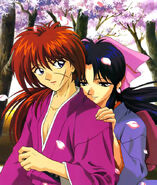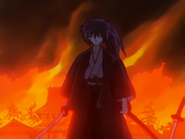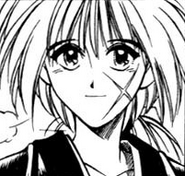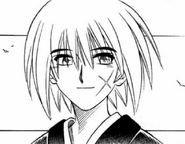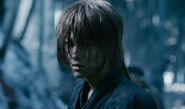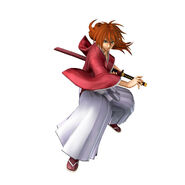Himura Kenshin, known as the legendary hitokiri of the Meiji Revolution, Himura Battōsai (緋村抜刀斎), is the main protagonist and titular character of the Rurouni Kenshin series. Kenshin has spent ten years traveling Japan as a rurouni in search of redemption, carrying a sakabatō with the vow to never kill again. In early 1878, he arrives in Tokyo and takes up residence at the Kamiya dojo, where his vow is tested as he fights to keep the country's peace.
Appearance
Of small, slender build and with a youthful, feminine visage, Himura Kenshin cuts quite a different figure than would be expected of the legendary Hitokiri Battōsai and his appearance belies his twenty-eight years of age, making him look roughly ten years younger, but he is easily recognized by his infamous distinguishing features: mid-back length red hair tied in a thick ponytail and a cross-shaped sword scar on his left cheek.
Kenshin's hair is thick and abundant, with all of the shorter frontal hairs falling across his face as bangs rather than being in the ponytail at the nape of his neck. During the revolution, Kenshin wore his ponytail higher and at the end of the series, he has cut the ponytail entirely and wears his hair evenly at about chin length. Kenshin's eyes, too, are unusual, being a deep violet. In the anime series, when Kenshin's eyes change to reflect his psychological reversion to Hitokiri Battōsai, their color shifts from violet to gold.
The Legendary Scar
Kenshin's cross-shaped scar actually consists of two separate scars--a long one running diagonally down his face from just below the outer corner of his left eye to just above his chin and a slightly shorter scar running diagonally across it in the other direction from just to the left of the bridge of his nose to his left jawbone. In a redesign for the kanzenban, Kenshin's scar has been altered so that the lateral scar is longer, stretching across his nose to just below the inner corner of his right eye.
Clothing
Kenshin dresses simply, wearing a plain men's kimono of cheap, worn cloth with a white umanori hakama, zori and white tabi. In the anime series, Kenshin's kimono is almost always a soft red like burgundy, but in the manga, he alternates between this, a bolder red, purple and deep blue. His sakabatō is worn under his obi at his left hip in a black, steel saya. in live action film Kenshin wear brown kimono
Personality
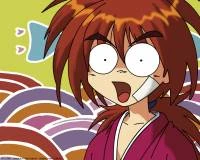
"Oro": Kenshin's trademark inerjection.
Soft-spoken, serene and humble, Himura Kenshin's usual demeanor suits his effeminate appearance perfectly. Always willing to put others before himself, both in terms of well-being and social standing, Kenshin usually refers to others with the noble honorific of "-dono" while nearly always speaking of himself with the particularly humble pronoun "sessha" (translated by Viz as "this one") and ending his phrases with the formal verb "de gozaru" (translated by Media Blasters as phrases like "that it is" or "that I am"). He carries himself with an air of amicable temperance, politely conversing with the people he encounters and freely giving his meager services to those who need a hand. Kenshin doesn't hesitate to put himself in the path of harm to shield those around him and often attempts to diffuse contentious situations with soft, calming words and a somewhat clownish personality involving feigned clumsiness and his trademark interjection "oro" (a unique pronunciation of "ara"). These traits lead those unfamiliar with Kenshin to view him as ineffectual or easily exploitable, but more perceptive people become aware in short order that his gift for placatory eloquence and veiled redirection of disagreeable situations suggest a deep wisdom belied by his youthful, unassuming visage.
Tormented by his past as a hitokiri, Kenshin has developed an acute appreciation for life and has taken a vow in his heart to never again kill another person and to do everything within his power to protect people from being killed. This vow is the defining characteristic of Kenshin's personality and the primary motivation for his transition into a rurouni. Despite this, however, he holds his own existence cheap and carries in his heart a grievous guilt that prevents him from becoming emotionally close to the people around him and compels him to a life of humble service and selfless personal sacrifice. Even with his prodigious skill as a prolific swordsman, Kenshin refrains from wielding his great combat strength for his own sake, drawing his sword only for the well-being of others when words fail to appease. Though unwilling to simply be killed by unrelated attackers, Kenshin freely accepts that any grudges against his past self are well-deserved; he remembers the face of every person he has wronged as the Hitokiri Battōsai and will face their hatred or judgment without complaint, believing that he does not deserve the same happiness as others. Spending much of his alone time in quiet contemplation of his past misdeeds and future retribution, Kenshin often ponders what the right path toward redemption is and laments each life lost due to his weakness. As such, he has a tendency toward trying to solve problems all by himself and alienating his would-be allies with secrecy so as to keep them from becoming involved in his risky endeavors. Having lived his own life carrying heavy regrets, Kenshin is reluctant to judge others for their personal actions, beliefs or mistakes and always offers hopeful encouragement so that those who have stumbled onto the wrong path might redeem themselves in the future. However, when forced to draw his sword against those who abuse their power and undervalue the lives of others, Kenshin's calm temperament gives way to a marked intensity capable of intimidating even other skilled swordsmen and can go so far as to become a powerful fury, despite his compulsion toward diplomacy.
But when his strength as a rurouni is insufficient to defend against a particularly threatening foe, Kenshin's restraint falters and his personality reverts to that of his days as the Hitokiri Battōsai. He immediately abandons his serene humility, reverting from sessha to the more abrasive pronoun "ore" while dropping de gozaru and oro from his speech. Kenshin's normally warm nature becomes cold and distant, allowing him to contemplate taking the life of his opponent and even make vicious, bloodthirsty threats. This side of his personality is one that Kenshin struggles to suppress despite the fact that it keeps emerging when he is under great stress and in need of extra strength. His greatest fear is that, one day, he will return to his former self and become a hitokiri once more.
As time passes, however, Kenshin learns to trust the people around him with the truth about himself as well as with some of the burden he bears, understanding that his life, too, is a human one and that his friends and allies would suffer greatly if he were to die.
Relationships
Allies
- Kamiya Kaoru: Moving gradually from dear friends to love interests to husband and wife, Kenshin and Kaoru share a relationship that serves as one of the largest focal points of the series. Though initially seeing Kaoru as merely another Japanese citizen in need of his protection, Kenshin is immediately struck by her remarkable philosophies regarding katsujinken and the unimportance of one's past self, quickly coming to see her as a particularly special person. Additionally, having been rescued from death, dishonor and loneliness by the mysterious rurouni, Kaoru greatly values Kenshin's company after he appears in her life and is rather insistent that he stay. The two grow steadily closer as time goes on, with Kaoru keeping Kenshin's darker nature in check with her kindness and Kenshin's eager support giving Kaoru the courage necessary to deal with the hardships of her life, until it becomes clear that neither can go on living happily without the other. Later on, they have a son together, Kenji, who loves his mother and hates his father. Kenji looks a lot like Kenshin.
- Sagara Sanosuke: Though initially an opponent hired by the Hiruma brothers (Gohei and Kihei), Sano becomes a member of the Kenshin-gumi in short order, serving as a sort of "strong right arm" at Kenshin's side during battle. Though Kenshin attempts to hide the dangerous aspects of his life in Tokyo from Kaoru and Yahiko, Sano is usually the first to see through the Rurouni's innocent deceptions and stubbornly tags along whenever he catches the scent of an impending fight. As such, Sano quickly becomes Kenshin's most trusted compatriot, proving himself capable of fighting his own battles without Kenshin's concern or intervention. Sano, for his part, silently reveres Kenshin's strength and character, devoting himself to making sure such a great man survives long enough to save as many people as possible.
- Myōjin Yahiko: Seeing young Yahiko's great spirit and sense of honor from their first accidental meeting, Kenshin comes to view Yahiko as an embodiment of the future, both in terms of the new Meiji society and the potential of kenjutsu. Though he is aware that Yahiko looks upon him as a hero, Kenshin insists that the boy learn Kamiya Kasshin-ryū from Kaoru rather than Hiten Mitsurugi-ryū and trusts the young shizōku to carry the ideals of "the sword that protects" into the new era. Kenshin is initially protective of Yahiko, mentoring him through example and wise speeches while he insists that the boy keep a safe distance from the dangerous goings-on in Kenshin's life, but eventually begins to see Yahiko as another of his comrades and trusts him to finish his own battles without being coddled. At the end of the series, Kenshin chooses Yahiko as his successor and gives him the Sakabatō as a Genpuku gift with the belief that the young man will carry on the will of katsujinken.
- Hiko Seijūrō XIII: Kenshin's master and the current heir to Hiten Mitsurugi-ryū, Hiko Seijūrō is a man whom he holds in great regard. From a young age, Hiko had mentored Kenshin in all the ways of the sword, life and the world, but on the other hand, Kenshin was given a rather unique vantage point from which to observe his master's vanity, selfishness and narcissism. Due to a difference in opinion, the two parted ways under rather unpleasant circumstances before Kenshin had the chance to complete his training. However, Kenshin knows that Hiko is a stalwart, trustworthy man, even if the master insists on belittling and humiliating his former student at every possible turn.
- Yukishiro Tomoe: The first love of Kenshin's life, Tomoe had an unparalleled effect on young Battōsai's demeanor, gradually easing him from a cold-blooded hitokiri into a soft-spoken, caring human being. However, their encounter was not fate but rather an orchestration by Himura's enemies. Despite her orders and her own private grudge against the Hitokiri Battōsai for revenge of her fiance's death , Tomoe gradually fell in love with the young swordsman and betrayed her comrades in an attempt to protect him from harm. As a result of the enemy's trap, however, Tomoe's life was cut short by Kenshin's own hand and his resultant guilt became a major factor in creating his new, gentler rurouni persona and his vow never to kill.
- Takani Megumi: Megumi often flirted with him, and he always looked a little embarrassed in those moments. Kenshin was one of the men who saved her life, taking her from the life of opium manufacturer. After that, she shows a great respect for the swordsman. She is considered "Kenshin's Fox" in Saitō Hajime's imagination.
- Saitō Hajime: Saitō and Kenshin were enemies at the time of End of Shogunate, since Kenshin fought for the Ishin Shishi and Saitō was one of the Shinsengumi, who were a special police force for the Shogunate. In their meeting at Kamiya Dojo they fought again, reviving the time when they were enemies fighting on opposite sides. Kenshin and Saitō became allies to defeat Shishio and Enishi but they never became friends the way Kenshin and Sano did. Saitō likes to fight for himself, so he will join Kenshin just when it's necessary, but both respect and admire each others' power and abilities. Kenshin once even refers to Saito (and the others with him on Enishi's island), as his 'trustworthy companion'.
- Shinomori Aoshi: Although initially enemies, Kenshin and Aoshi eventually become comrades, when Kenshin re-awakens his senses, after the latter is in a constant state of deep trauma, following the honorable sacrifices of his loyal subordinates, who perished saving his life. Aoshi aids Kenshin in his battle against both Shishio and Enishi.
Enemies
- Shishio Makoto: Successor to Hitokiri Battōsai, he plans to take over Japan, but his plans are thwarted by Kenshin and his allies, after a long, hard-fought series of battles.
- Yukishiro Enishi: He was Kenshin's brother in law when Kenshin married his sister Tomoe. Like Tomoe, Enishi sought revenge against Kenshin for Akira's death and after Kenshin mistakingly killed Tomoe, Enishi's rage fueled multifold. In the end, 15 years later, he was barely defeated by Kenshin and after learning Tomoe's true feelings for Kenshin through her diary, he gave up his quest for revenge.
Abilities
Kenshin, in keeping with his soft appearance, appears to be quite skilled at domestic work as many of the Kamiya dojo residents comment favorably on his cooking and he is frequently seen performing such tasks as grocery shopping, floor and shoji door cleaning and laundry. While he does all of these things diligently and eagerly, it appears that his taste for them is an acquired one which he displays only to strangers and new acquaintances, as he was loath to perform even the simplest chore on Hiko Seijūrō's orders. However, it has also been shown that Kenshin's handwriting is not very good (with several characters comparing it unfavorably to that of Watsuki's).
Kenshin is also an unparalleled orator, capable of spinning eloquence or humor into an offhand comment and prone to making grand, moving speeches off the top of his head. While maintaining his cool, he is rather adept at philosophical arguments, swiftly seeing the cracks in any opponent's logic without missing a beat in conversation.

Kenshin cutting through opponents at high speed
Kenshin is perhaps most well known for his almost inhuman swordsmanship. Having inherited the Hiten Mitsurugi-ryū sword style from his master, Hiko Seijūrō XIII, Kenshin's light frame allows him to use the style's "godspeed" to its fullest, moving so rapidly that he routinely outpaces the human eye, and his own prowess with Battōjutsu earned him his infamous moniker.
Outside of Hiten Mitsurugi-ryū, Kenshin has displayed independent sword techniques which are indicative of his own acquired skills:
Miscellaneous techniques
- Modoshigiri
- The most skilled swordsmen using the best of blades were supposedly able to slice an object in two and rejoin the halves together, as if it were never cut at all. Kenshin demonstrates this when he cuts a daikon and then reforms it back together. He doesn't cut it with his sword, but rather a kitchen knife, since his sakabatō was broken at that time.
- Zantetsu
- The most skilled swordsmen were purportedly able to use their swords to cut through steel. Kenshin states he can use it anywhere except underwater.
History
Early Life
Kenshin is born into a peasant family under the given name of "Shinta". After losing both his parents to cholera by age seven, he is sold into slavery. The slave-traders' caravan is attacked by bandits who kill all of the peasants except for Shinta, who is saved by a skilled swordsmanship master named Hiko Seijūrō. He renames the boy "Kenshin", as the name 'Ken' (sword) and 'Shin' (heart) were more fitting for a swordsman.
After a few years under Seijūrō's guidance, Kenshin's wish to protect the people with his skills results in his abandonment of both his master and his training, which was left incomplete and with a heated bitter departure. His sword skills soon attract the attention of Katsura Kogorō, a leader of the Chōshū clan. Kenshin is sent to Kyoto and assigned the role of an assassin, sharing the common goal of the Ishin Shishi upon the Tokugawa shogunate. Within the first six months of his career, he kills over 100 people, and eventually becomes known as the "Hitokiri Battōsai".
At one point, he comes face to face with a woman named Yukishiro Tomoe, who initially wanted to avenge the death of her fiancé whom Kenshin had killed, but falls in love with him instead and starts a romantic relationship. After the crisis suffered by the Chōshū clan in the Ikedaya Jiken, both Kenshin and Tomoe act as a married couple to keep anyone from finding out Kenshin's true identity as an assassin and flee to a remote village.
Sometime later, Tomoe meets with the leader of the Yaminobu, a fictional pro-Shogunate covert network of ninjas that had formulated a plan to assassinate Kenshin. She realizes that all along they had actually used her to create Kenshin's weakness. Meanwhile, Kenshin runs off to find his wife, but is ambushed by Yaminobu ninjas and is severely wounded. He manages to defeat them and eventually finds Tomoe with the leader of the Yaminobu. In a desperate attempt to defeat the leader, Kenshin blindly swings his sword, killing both his assailant and Tomoe, who jumps in at the last minute to save Kenshin from a fatal attack. Tomoe's knife flies into the air and coincidentally slashes Kenshin's already scarred cheek, creating the famous X-shaped scar across his left cheek. Before dying, her last words come to reveal the dark tragedy that ultimately leaves Kenshin forever changed.
Following the death of Tomoe, Katsura, feeling heavily responsible for Kenshin's loss and his manipulation under the miserly traitor Iizuka, recruits Shishio Makoto to replace him as an assassin, and reassigns him as a guerrilla swordsman protecting the Imperialists. After the end of the Bakumatsu, Kenshin leaves the Ishin Shishi's ranks, his experiences resolving him to protect those unfortunate without the need for death and bloodshed. Arai Shakkū, a famed swordsmith of the Ishin Shishi and acquaintance of the Battosai, realizing the change that the turbulent era brought on to his friend, the virgin perspective that he now has resolved to keep, and concerned how his friend would carry his journey without the need for self defense and necessary force to carry out his ideals against the wayward, issues him the challenge to uphold his newfound path and tosses him the first of his signature weapon into the future, the kageuchi of the Sakabatou, marking Kenshin's end as a Hitokiri.
Settling in Tokyo
After finishing his job as the murderer "Hitokiri Battōsai" in the Ishin Shishi, Kenshin assumes the life of a wanderer, keeping his promise to protect every individual from danger without harming others through pacifist means, and through the use of Hiten Mitsurgi's powerful techniques and true principles of the art.
Ten years after the Revolution, he arrives in Tokyo, where he meets Kamiya Kaoru. She invites him to stay in her dojo even after she discovers that Kenshin is the "Battōsai". During his residence in the dojo, Kenshin establishes lifelong relationships with many people, and changes the lives of many who he has met; even if his reputation of a notorious assassin in the day of the Bakumatsu and the animosity of those begrudged who have survived its bloody days come to haunt him, his change as a person has even lead ex-enemies, such as the former Shinsengumi member Saitō Hajime, to come to peaceful terms with him. With the many friends he has come to make, many of their experiences come to take them on adventures in the changing world of the historical Meiji era and the events they come to impact on both them, and the world to come.
Although his has kept his promise and fulfills his duty as a swordsman of peace, many of his inner scars still come to haunt him, from his repressed hitokiri personality coming out in times of heavy conflict, to the heavy trauma and unremedied pain that keeps him distant from even his closest friends, and fearful of the consequences his past reemerges should they be dragged into them. New enemies such as Aoshi Shinomori of an Oniwabanshū turned mercenary thug criminal group, comes to bear a near vendetta rivalry to claim his life in order to mark their pride in history as the strongest of the Bakumatsu's days, and Jinei Udoh nearly comes to make Kenshin break his vows and spill blood after holding Kaoru hostage in threat of her life, before leaving behind a dark memento and reminder that the past of a warrior will always come to haunt him and leave no other path open to him than one of destruction.
Kyoto Arc
Though peace and resolute resolve guided Kenshin's days, a surprise meeting between his rival adversary Hajime Saito and old ally Okubo Toshimichi gave news of the advent of Shishio Makoto, the brutal former successor to Kenshin's position as Chōshū Shishi's assassin. Masterminding a movement seeking to overthrow the Meiji Government and establish his own tyrannical Social Darwinist reign, Kenshin comes to leave Tokyo upon their planned assassination of Okubo, with fear that the battle ahead would be brought too close to home and drag his friends and family into the harrowing tragic depths his past would surface about in the present.
To defeat such a foe, Kenshin is forced to return to Kyoto, the city of both his pain and the stronghold of Shishio. Before departing, he first said goodbye to Kaoru. Along his journey to the Imperial Millennium Castle City, he gains the accompaniment of Makimachi Misao, a traveling ninja of Kyoto's Oniwabanshu in search of a missing Aoshi. Upon the discovery of a battered and bloodied Mishima Ei'ichirō, and the arrival of Saito during the subduing of Shishio's residing forces, they witness both the atrocities Shishio's accomplishments have brought about, and the possible future that would come about under his iron fisted rule, in the hamlet of Shingetsu Village. Having broken his sakabato clashing swords with Sojiro the Tenken of Shishio's upper ranks, and realizing his strength is inefficient enough to stop Shishio without returning to the hitokiri within, Kenshin resumes his quest with a few new friends, a newfound resolve, and new tasks to stop his enemy.
Upon arrival to Kyoto, his first errand would to fulfill the promise of reuniting with his old friend Arai Shakkū, to receive a new sakabatou; second, to complete the final stages of correspondence of the Hiten Mitsurugi school, and mend his severed relationship with his teacher Seijūrō. With a newfound allegiance and introduction to the Aoiya's staff, the now current Kyoto branch Oniwabanshu, Okina of their ranks helped the rurouni scout out and find both persons of importance.
The first person to find, Arai Shakku, was unfortunate, as he passed on years prior to his arrival in Kyoto; however, he was succeeded by his son, Arai Seikū. Although reluctant at first, and still in shame over the shady reputation his father brought upon himself and the craft he was reknowned for, Kenshin, Okina, and Misao came at the call to save Seiku's son Arai Iori from the hands of Sawagejō Chō "The Swordhunter", and revealed to him, not just of his father's own philosophy of how it was up to the men who wield weapons that build the new era, but that Kenshin was also one of those men who fought for the future safety and peace of Japan. From proving to him that he only meant benevolence and noble deeds, the Arai Family happily gave him the final work of Arai Shakku, the shinuchi of the hallowed sakabatou.
After obtaining the shinuchi of the sakabatou, Kenshin was now able to undergo his second errand. Under the pseudonym Ni'tsu Kakunoshin, the current master of the Hiten Mitsurugi school made his current living as a skilled potter. Attacking him to make an entrance, Hiko Seijuro the XIIIth was surprised to see his student return after 14 years. Explaining to him of the situation at hand, Hiko nonetheless analyzed and scrutinized his student with impeccable accuracy; not only did his reckless idealism come to fail to understand that the ideals of the Hiten Mitsurugi school teach that those who wield the school's techniques fight for their fellow man, not for the illusions of sides or allegiances of any sort, and how the tragedies he had inflicted and suffered had now left deep scars on his psyche, while he still held the mind of an immatured 14 year old boy, his actions altogether while in the ranks of the Ishin Shishi indirectly came to bring about Shishio's maniacal agenda and current existence. Infuriated, annoyed, and agitated at the ignorance of Kenshin, Hiko was about to dishonorably dismiss his apprentice, although not before the arrival of Misao, Yahiko, and to great surprise, Kaoru Kamiya, at his master's doorstep.
Moved by the stories, exploits, and experiences his friends told, Hiko reconsidered and came to continue his apprentice's mastery. Through the harsh regiments, teaching him not only powerful techniques, Hiko also was instrumental in consoling Kenshin and the scars the plagued him; from reminding him that, although he sees himself as selfless and one who would be glad to help those in need, to the point of self sacrifice, he is also only a human being, and that if he were to die, no doubt that those close to him would be utterly devastated. This key truth was the very thing for Kenshin to overcome both his fatalistic hitokiri alter ego, and his master's fatal trial of the Kuzuryūsen, becoming the wellspring of power needed to execute the Hiten Mitsurugi school's ultimate and pinnacle technique, the Amakakeru Ryū no Hirameki.
Upon the completion of his training and the nursing of his master back to health, Kenshin left to Kyoto, and with newfound strengths, ready to take on Shishio. Much to his surprise, several of his friends tracked him down to Kyoto to help him defeat Shishio and the Juppongatana. Foiling his first diabolical plan of the Kyoto Grand Fire and the invasion of Tokyo with the blackship Purgatory with his allies, the Kenshingumi had made it known that they were a force to be reckoned with.
Realizing his new foe wasn't just an ordinary enemy, and a formidable threat to his conquests, Shishio and the Juppongatana agreed on the arrangement of a series of duels at their hideout, the Shrine of the Six Tori on Mt. Hiei. Accompanied with Sanosuke and Saito, the three made their way to the compound early morning next day; while Sanosuke took on the vengeful fallen monk and former mentor "Bright King" Yukyuzan Anji, Saito taking on the murderous "Blind Sword" Usui Uonuma, and learning of the underhanded assault on the Aoiya, Kenshin took the brunt of the series of duels on Mt. Hiei, facing off two formidable opponents in a series of rematches; first against the wildcard traitor Aoshi Shinamori, to return him to his senses for the sake of both the Kyoto Oniwabanshu and Misao, his admirer and student, as well as the youth swordsman prodigy Seta Sojiro, responsible for destroying his kageuchi of the sakabatou and the assassination of Okubo Toshimichi, before facing off against his terrible successor, Shishio Makoto himself. Kenshin used Amakakeru Ryū no Hirameki to defeat both Aoshi and Sojiro.
The battle against Shishio for Kenshin was no eased matter. Weakened and wounded earlier by prior duels, and pushing damage even further on to him, not even the combined efforts of Saito, Sanosuke, and even a reformed Aoshi would come to see Shishio fall. But as Kenshin fell during battle, the duration of his ally's attempts would buy him enough time to recover from Shishio's brutal onslaught eariler, from the grisly bite marked on his left shoulder to even the explosion of the Guren Kaina. Fueled with an intense will to live brought on by his training and his promise to Kaoru, and his swordsman spirit surging with the winds and flora of the valley arena, his undying spirit, even pushing his body near the brink of death and to its limits, unleashed furious blows and his most powerful technique Amakakeru Ryū no Hirameki. Shishio countered the first strike of Amakakeru but not the second strike. Shishio was greatly damaged by the move and ran his sword through Yumi in an attempt to hit Kenshin. Kenshin was critically wounded on the floor by the stab. Kenshin thinks that it was the end, but upon remembering his master Seijuro's words that the girl who came all the way from Tokyo (Kaoru) would be devastated if he were to die, his will to survive strenghtened. At the end of the battle, even as he was grievously wounded with little to spare, his will to survive overcame and outlasted Shishio's bodily limits, who ignites into a flame (spontaneous combustion) due to overheating.
Making a full recovery after a month unconscious and with the help of Megumi Takani, Kenshin's quest was fulfilled, and the country of Japan saved, but not without doubts, knowing that if battle and who was the strongest means that victory also means one is in the right, then Shishio was right all along; still, he thought, such a world and where its people would agree on such a brutal ideal, would be wrong no matter what. Even if victory was hollow, this would not mean that his actions were in vain- The ones close and who cherished him, who he changed their lives, and who came to also have done the same for him; Sanosuke, Misao, Megumi, Yahiko, the Oniwabanshu, Hiko Seijuro, Arai Seiku and his family, those who he left behind in Tokyo, and Kaoru, would always be happy and welcome to have him in their family, and proud of his deeds to ensure a world where peace and freedom would come about. Kenshin would return to Tokyo, ending his wandering again, back to a welcome home at the Kamiya Dojo.
Jinchū Arc
Months later, a man known as Yukishiro Enishi starts attacking all people that Kenshin meets as an act of revenge for the death of his sister Yukishiro Tomoe. At this moment, it is discovered that Kenshin was married to Tomoe during the revolution, but accidentally killed her while trying to rescue her from a group of assassins. When Enishi finds out about Kenshin's feelings towards Kaoru, he sets out to kidnap her. He succeeds and leaves behind a professionally-made decoy of Kaoru with a sword in her heart, making everyone believe that she had been murdered. Kenshin falls into severe depression and runs off to a village of wanderers to mourn. However, he breaks out of his depression after his friends discover Kaoru is alive. The group goes to rescue her on Enishi's island. A battle between Kenshin and Enishi follows and when Kenshin wins, he and Kaoru return home.
Five years later, Kenshin is married to Kaoru and has a son named Himura Kenji. After an encounter with Kaoru's student Myōjin Yahiko who he has teach his own sword style during the past five years. They have a spare which Kenshin wins but barely as sign of Yahiko coming of age he gives him his own reverse blade sword.
In Live-action film
A close up of Kenshin's scar.
He was played by Takeru Satō in the 2012 Rurouni Kenshin live action film. The film begins when Kenshin and Saito are on opposing ends during the Battle of Toba Fushumi. Saito pursues his rival, but the battle is already lost before he can find him. Kenshin abandons his old ways, becoming a rurouni and vowing never to kill again. Ten years later, he finds himself in Tokyo.
Sato will repise his role in two sequels of the film.
Development and reception
He is the main protagonist for the series and has developed into a media franchise, which consists of a series of manga, anime, original video animations (OVAs), movies, soundtracks, video games, and other collectibles. When creating Kenshin, Watsuki designed him to be the physical opposite of Hiko Seijūrō, a character that appears in Watsuki's first one-shot manga, Crescent Moon in the Warring States, and later in Rurouni Kenshin as his swordsmanship teacher.
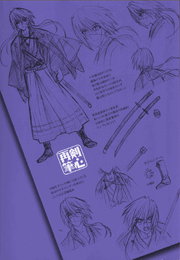
Kanzenban Redesign
Kenshin's character was well received by fans, with his holding the top spot in all reader popularity polls for the series. Critics of the series praised his personality, though some complained about his development during the anime OVA series, which differs from the manga. A variety of collectibles based around Kenshin have been created, including figurines, key chains, plushies, and replicas of his sakabatō sword. Watsuki discovered and used the story of Kawakami Gensai, a hitokiri executed by the Meiji Government. According to Watsuki, when he found that Kawakami maintained a duty to his dead comrades, he decided to create the title character. Since Watsuki's debut work contained a tall, black-haired man in "showy" armor, the creator wanted to make a character "completely opposite" to the debut character and the new character ended up "coming out like a girl." According to Watsuki, he used "no real motif" when creating Kenshin and placed a cross-shaped scar when "not knowing what else to do."At the end of the series, Kenshin appears with short hair. Initially, Watsuki had planned to make his hair shorter before the end, however, he found this to be similar to the character Multi from To Heart.Watsuki based most of Kenshin's abilities on a real swordsman of the Tokugawa period named Matsubayashi Henyasai, who was skilled in acrobatic techniques.During the Kyoto arc, Kenshin is given a new sword with a sheath made of wood. Watsuki decided to redesign the sword to make it look as the first one Kenshin had in the series, though it is more difficult to draw.During the development of Rurouni, Meiji Swordsman Romantic Story, Watsuki and his editor argued over Kenshin's speech patterns; they settled for a "slangy" pattern. For the final version of the first Romantic Story, Watsuki adjusted the dialogue; in his view, he made Kenshin sound "more as I prefer him now."Watsuki added Kenshin's trademark "oro" as a placeholder to be an expression of the English speech disfluency "huh." Watsuki notes that he was surprised at how much it caught on, and how much he ended up having Kenshin use the sound during the series.Watsuki also planned to make Kenshin older than 30 years old; his editor commented that it was strange that the main character of a manga for teenagers was so old, so he made Kenshin 28 years old.In the first Rurouni Kenshin kanzenban, published in Japan in July 2006, Watsuki included a draft page featuring a redesign of Kenshin's character. To make his X-shaped scar more notable, Watsuki made it long enough to cross his nose. Kenshin's hair is tied in two tails, which are flowing to make him look younger, but shorter, to be less androgynous. Watsuki also added a habaki to Kenshin's sword to make it easier to draw by simplifying its structure, while also emphasizing strength.Kenshin's hitokiri look was also redesigned slightly, by making his clothes more damaged and giving him Yukishiro Tomoe's neck scarf.In the anime adaptation of Rurouni Kenshin, Watsuki's designs were combined with the voice talents of Mayo Suzukaze, a female seiyū. In producing the English dub version of the series, Media Blasters considered following suit, with Mona Marshall considered as a finalist for voicing Kenshin. Richard Hayworth eventually was selected for the role, giving Kenshin's character a more masculine voice in the English adaptation. Marshall was selected instead to voice the younger Kenshin during flashback scenes. Clark Cheng, writer of the dub script, noted that localizing Kenshin's unusual speech was a difficult process. His use of "de gozaru" and "oro" were not only character trademarks that indicated Kenshin's state of mind, but important elements to the story. However, neither is directly translatable to English, and in the end the company chose to replace "de gozaru" with "that I did" and "that I am." Kenshin's signature "oro" was replaced with "huah" to simulate it being a "funny sound" that had no real meaning.
Appearances in other media
Kenshin first appears in two chapters of Rurouni, Meiji Swordsman Romantic Story in which he arrives in Tokyo and defeats several groups of villains attacking families. In these stories, Kenshin is given a similar personality to the one he has in the series but his name is unmentioned.
Later, in the movie Samurai X The Motion Picture, Kenshin meets a samurai named Takimi Shigure, the head of an underground resistance whose ranks comprise of samurai loyal to the Tokugawa Bafuku, notably the dissatisfied remnant factions and descendants of Aizu and the Shōgitai, who tries to overthrow the Meiji Government and avenge the deaths of his family during the Bakumatsu. As his dark past as Hitokiri Battosai also ties into Shigure's days of the Bakumatsu, Kenshin is needed to stop Shigure before his actions throw Japan into turmoil once more.
In the OVAs, Kenshin is given a more humanized design and a different personality. There are also numerous changes to his life story compared to that of the manga, including the way he received his X-shaped scar in Samurai X: Trust & Betrayal.
Samurai X: Reflection is an "epilogue" to the series. Set long after the series' end, the movie expands upon a series' summary of Kamiya Kaoru's perspective of events, and on the future of a battle weary Kenshin ravaged by a life threatening disease. Many consider its depiction of Kenshin's future, including Nobuhiro Watsuki, uncanon, mainly due to lack of creative input from its series' creator and his objections to how Kenshin was treated overall through the film.
Kenshin is a playable character in all of the Rurouni Kenshin video games, including Jump Super Stars and Jump Ultimate Stars. Tokiko Tsumura, one of the main characters of Buso Renkin, another series created by Watsuki, is based on the design of Kenshin as a hitokiri. Watsuki commented that Tokiko is the female version of the "Hitokiri Battōsai" when he drew her face.
Reception
Kenshin has been highly popular with the Rurouni Kenshin reader base, having ranked first in every Shonen Jump popularity poll of the series, always with more than double the votes of second place. Watsuki received letters from fans describing Megumi Ogata's audio theatre voice as a "good fit" for Kenshin. Watsuki said that he imagined Kenshin's voice to be "more neutral." A plethora of merchandise have been released in Kenshin's likeness including keychains, action figures, and plush dolls. Since the manga was published, non-functional and functional sakabatō have been produced for purchase by collectors and fans.
Several publications for manga, anime, video games, and other media have provided praise and criticism on the character. T.H.E.M. Anime Reviews criticized that the fact that Kenshin looks super deformed in comedy scenes is not suited for the context of the character and the series. AnimeOnDVD.com remarks that Kenshin has a "smartass" attitude in a review of volume 8; while they noted that is a common attitude in the anime that makes him look out-of-character. Anime News Network praises Kenshin for being a character that all people enjoy to watch due to his comedy scenes. SciFi.com remarked "Kenshin's schizoid personal conflict between his ruthless-killer side and his country- bumpkin" as a perfect way to develop good stories. The development of Kenshin in the OVA series has had negative reviews by many publications. Anime News Network also adds that in Samurai X: Reflection he continues to be his old mopey self and criticizes that he never says "oro," while IGN cited that some moments of the relationship between Kenshin and Kaoru were depressing.However, some reviewers noted Kenshin's personality in the OVAs to be one of the most complex to ever be animated remarking the fact that he can not forget his bloody past, although having a peaceful life. A large number of video game characters were based on the character of Kenshin such as Keiichiro Washizuka from The Last Blade and Shizumaru Hisame from the Samurai Shodown series. Kenshin's personality was also planned to be used in the character Kakashi Hatake from Naruto, but the idea was deemed as a failure. In an interview with Mayo Suzukaze, who is the seiyū for the character, she says that she started feeling similar to Kenshin after years of work as his voice, and comments that providing the voice for the character was one of her best experiences.

